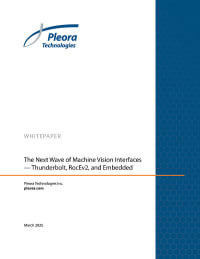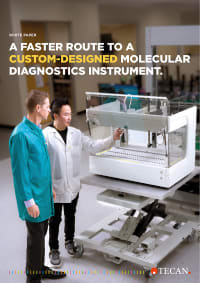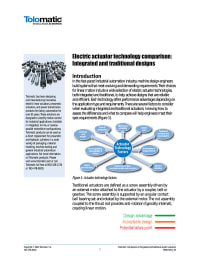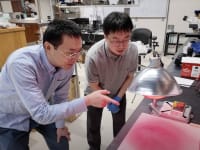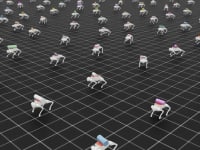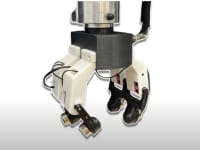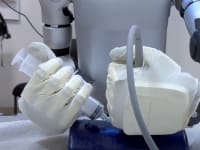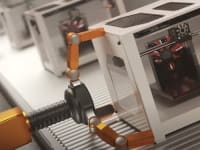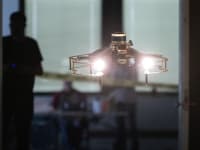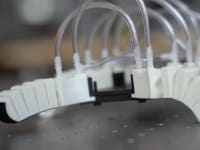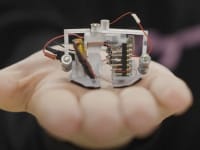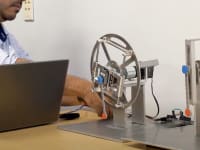Briefs: Software
Robots may soon have a new way to communicate with people. Not through words or screens, but with light and images projected directly onto the world around them. University of South Florida's Zhao Han is developing technology that could transform how people interact with robots in both emergencies and everyday life. Read on to learn more.
Briefs: Materials
Soft robots, medical devices and implants, and next-generation drug delivery methods could soon be guided with magnetism — thanks to a metal-free magnetic gel developed by researchers at the University of Michigan and the Max Planck Institute for Intelligent Systems in Stuttgart, Germany. Read on to learn more about it.
Briefs: Medical
A study conducted by Fuyang Yu and his colleagues introduces an innovative approach to lower limb rehabilitation. Their research outlines the development of a lower limb rehabilitation robot designed to significantly improve the safety and effectiveness of gait training through a novel method based on human-robot interaction force measurement. Read on to learn more.
Briefs: Energy
This lightweight, portable garment is designed for active shoulder and elbow positioning.
Briefs: AR/AI
Researchers at Fuzhou University in China created a machine vision sensor that uses quantum dots to adapt to extreme changes in light far faster than the human eye can — in about 40 seconds — by mimicking eyes’ key behaviors. Their results could be a game changer for robotic vision and autonomous vehicle safety. Read on to learn more.
Briefs: Robotics, Automation & Control
Researchers from MIT and NVIDIA Research have developed a novel algorithm that dramatically speeds up a robot’s planning process. Their approach enables a robot to “think ahead” by evaluating thousands of possible solutions in parallel and then refining the best ones to meet the constraints of the robot and its environment. Read on to learn more.
Briefs: Robotics, Automation & Control
Animals like bats, whales, and insects have long used acoustic signals for communication and navigation. Now, an international team of scientists have taken a page from nature’s playbook to model micro-sized robots that use sound waves to coordinate into large swarms that exhibit intelligent-like behavior. Read on to learn more.
Briefs: Physical Sciences
A team of engineers has developed a low-cost, durable, highly-sensitive robotic ‘skin’ that can be added to robotic hands like a glove, enabling robots to detect information about their surroundings in a way that’s similar to humans. Read on to learn more.
Briefs: Robotics, Automation & Control
A new AI training protocol teaches robots how to perform complicated tasks, like assembling a motherboard or an IKEA drawer, with a 100 percent success rate. Read on to learn more about it.
Briefs: Aerospace
NASA has developed an innovative combination of a Magnetometer, low-powered ElectroMagnets, and Resonant Inductive Coupling (MEMRIC) to create and control relative positioning of nano satellites within a cluster. This is a game-changing approach to enable distributed nanosatellite (nanosat) clusters. Read on to learn more.
Briefs: Sensors/Data Acquisition
Researchers from Duke University have developed a novel framework named WildFusion that fuses vision, vibration, and touch to enable robots to “sense” complex outdoor environments much like humans do. Read on to learn more.
Briefs: Software
A human clearing junk out of an attic can often guess the contents of a box simply by picking it up and giving it a shake, without the need to see what’s inside. Researchers from MIT, Amazon Robotics, and the University of British Columbia have taught robots to do something similar. Read on to learn more.
Briefs: Manufacturing & Prototyping
Imagine a robot that can walk, without electronics, and only with the addition of a cartridge of compressed gas, right off the 3D printer. It can also be printed in one go, from one material. That is exactly what roboticists have achieved in robots developed by the Bioinspired Robotics Laboratory at the University of California San Diego. Read on to learn more.
Briefs: Mechanical & Fluid Systems
Researchers have created a light-powered soft robot that can carry loads through the air along established tracks, similar to cable cars or aerial trams. The soft robot operates autonomously, can climb slopes at angles of up to 80°, and can carry loads up to 12 times its weight. Read on to learn more.
Briefs: Software
Researchers from MIT and NVIDIA Research have developed a novel algorithm that dramatically speeds up a robot’s planning process. Their approach enables a robot to “think ahead” by evaluating thousands of possible solutions in parallel and then refining the best ones to meet the constraints of the robot and its environment. Read on to learn more.
Briefs: Robotics, Automation & Control
Specialized robots that can both fly and drive typically touch down on land before attempting to transform and drive away. But when the landing terrain is rough, these robots sometimes get stuck and are unable to continue operating. Now a team of Caltech engineers has developed a real-life Transformer that has the “brains” to morph in midair, allowing the dronelike robot to smoothly roll away and begin its ground operations without pause. Read on to learn more.
Briefs: Robotics, Automation & Control
University of California Berkeley biologists and engineers have designed a hopping robot that can stick a landing on a narrow perch. The feat is a big step in the design of more agile robots, ones that can leap among the trusses and girders of buildings under construction or robots that can monitor the environment in tangled forests or tree canopies. Read on to learn more.
Briefs: Robotics, Automation & Control
Researchers have developed a compact and versatile robot that can maneuver through tight spaces and transport payloads much heavier than itself. Smaller than a credit card and weighing 6 grams, the nimble swimming robot is ideal for environments with limited space like rice fields, or for performing inspections in waterborne machines. Read on to learn more.
Briefs: Motion Control
It’s a game a lot of us played as children — and maybe even later in life: unspooling measuring tape to see how far it would extend before bending. But to engineers at the University of California San Diego, this game was an inspiration, suggesting that measuring tape could become a great material for a robotic gripper. Read on to learn more about their robot, GRIP-tape.
Briefs: Design
The piezoelectric “meta-bot” is capable of propulsion, movement, sensing, and decision-making.
Briefs: Imaging
Innovators at NASA Johnson Space Center have developed a robotic system whose primary structural platform, or “orb,” can be injected into a pipe network and perform reconnaissance of piping infrastructure and other interior volumes. When deployed, this technology uses throttled fluid flow from a companion device for passive propulsion. Read on to learn more.
Briefs: Medical
Researchers have developed a tiny magnetic robot that can take 3D scans from deep within the body and could revolutionize early cancer detection. The team, led by engineers from the University of Leeds, said this is the first time high-resolution 3D ultrasound images taken from a probe deep inside the gastrointestinal tract, or gut, have been generated. Read on to learn more.
Briefs: Robotics, Automation & Control
These materials can detect when they are damaged, take the necessary steps to temporarily heal themselves, and then resume work.
Briefs: Robotics, Automation & Control
A team of MIT engineers has developed a training method for multiagent systems that can guarantee their safe operation in crowded environments. Read on to learn more about it.
Briefs: Robotics, Automation & Control
Researchers at Universidad Carlos III de Madrid have developed a new soft joint model for robots with an asymmetrical triangular structure and an extremely thin central column. This breakthrough, recently patented, allows for versatility of movement, adaptability and safety, and will have a major impact in the field of robotics. Read on to learn more.
Briefs: Software
A new study, published in the journal Results in Engineering, introduced a meticulously designed dataset aimed at enhancing the performance of 6D pose estimation algorithms. Read on to learn more.
Briefs: Robotics, Automation & Control
Scientists have developed multi-modal 3D object detection methods that combine 3D LiDAR data with 2D RGB images taken by standard cameras. While the fusion of 2D images and 3D LiDAR data leads to more accurate 3D detection results, it still faces its own set of challenges, with accurate detection of small objects remaining difficult. Read on to learn more about it.
Briefs: Wearables
Jamie Paik and colleagues in the Reconfigurable Robotics Lab in EPFL’s School of Engineering have developed a sensor that can perceive combinations of bending, stretching, compression, and temperature changes, all using a robust system that boils down to a simple concept: color. Read on to learn more about it.
Briefs: Motion Control
In a recent study published in the journal eLife, an international research group has studied the relationship between electrical stimulation in stick insects’ leg muscles and the resultant torque (the twisting force that makes the leg move). Read on to learn what they found.




